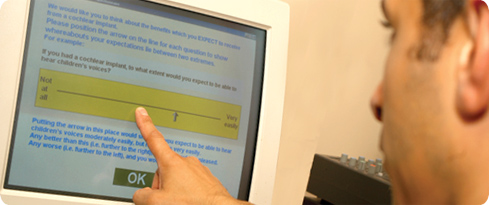Your views

Your feedback is vital to us as we continue to increase the quality of our services.
You are here:
Date: 20 April 2024
Time: 02:43

Implant assessment process
Cochlear implant assessment process
The initial assessment takes place in a hearing implant clinic at the Queen Elizabeth Hospital Audiology Centre (QEHAC) in Birmingham. You will have a hearing test and also a test listening to sentences with your hearing aids. Then you will meet your ear, nose and throat (ENT) consultant and members of the Hearing Implant Team. We will discuss your hearing history and give you an opportunity to ask questions about implants.
At the end of the appointment it will be decided whether or not you will go on to the next stage of assessment. The team may decide that a cochlear implant is not for you. This may be because you have too much residual hearing or there may be other medical factors that would make a cochlear implant unsuitable. If it is agreed that you might be a suitable candidate, an appointment will be made for you to visit QEHAC again.
If you proceed to a full assessment, you will be seen by an audiologist and a hearing therapist for a more thorough evaluation. This may involve more than one visit to the centre and we encourage you to bring a family member or partner with you.
The assessment
The assessment may involve the following:
- Assessment of your current hearing aids – make sure you bring these with you, with well-fitting earmoulds
- Lip-reading tests
- Speech perception testing
- Hearing aid re-fitting, if required
- Communication evaluation
- An explanation of cochlear and other implants and how they work
- Expectations counselling
- An opportunity to meet an implant user
- Device counselling
- Auditory brainstem response (ABR) test – involves listening to click sounds while a computer records the response of the hearing pathway up to the brainstem
- Balance system test – measures how well the balance organs are working in each ear
- CT scan – special X-ray scan of the inner-ear bones
- MRI scan – special magnetic scan of the inner ear structures
At the end of the assessment, members of the team write a report on their findings. The team meets to decide whether a hearing implant or other treatment is appropriate for you. You will then be invited back to an implant decision clinic to meet the ENT consultant and the team again. All pre-admission tests will be done at this appointment, including a routine precautionary vaccination against meningitis.
We will let you know the results of our assessments and whether or not we recommend an implant. If an implant is appropriate for you, a date for your surgery will be arranged, pending agreement of funding from the appropriate funding body. When a surgery date has been arranged, you will be asked to return to QEHAC to collect your sound processor so you can become familiar with your device prior to your switch-on.
All cochlear implant surgery takes place at Queen Elizabeth Hospital Birmingham. You will be invited to come to the ward before the operation. Most people can go home the day after surgery.
Middle ear implant (MEI) assessment process
For patients referred for an assessment for MEI the process differs only in that you will attend at QEHAC to begin your assessment without coming to an initial clinic first. This is because it is essential to evaluate whether conventional hearing aid amplification may the best option before consideration of surgery. The assessment will proceed as for a hearing implant and at the end you will be invited to a clinic to discuss the results and plan your future care.
Related pages

Getting here
Information about travelling to, staying at and getting around the hospital.

Jobs at UHB
A great place to work. Learn why.


